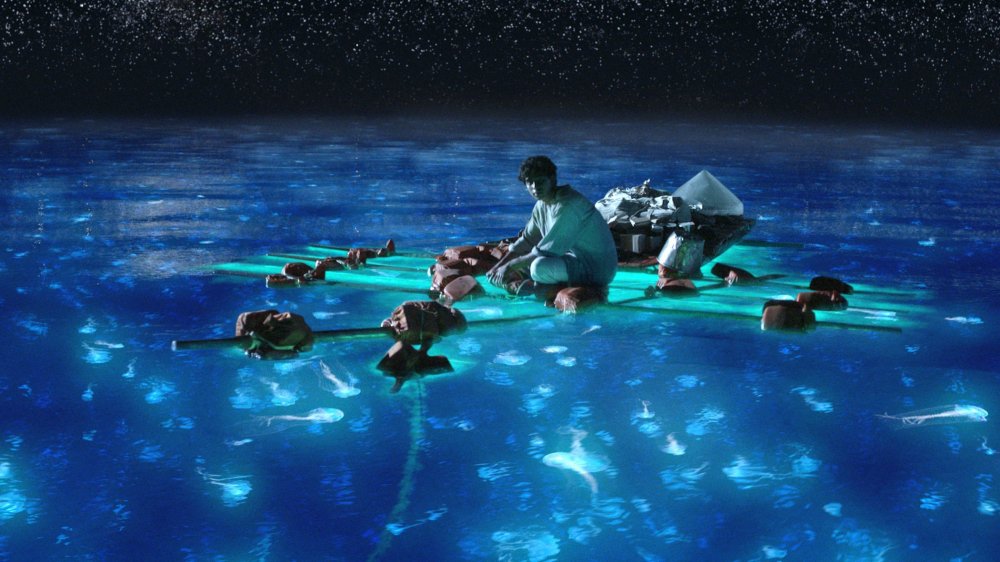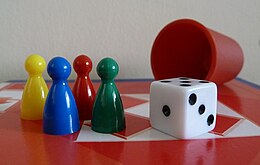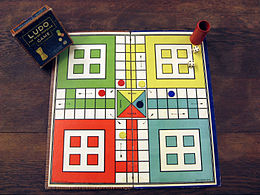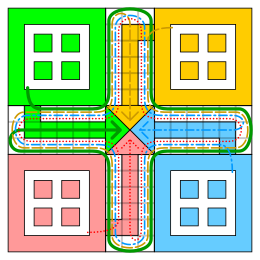Life of Pi
This article is about the novel by Yann Martel. For the film based on the novel and directed by Ang Lee, see Life of Pi
Life of Pi is a Canadian philosophical novel by Yann Martel published in 2001. The protagonist is Piscine Molitor "Pi" Patel, an Indian Tamil boy from Pondicherry who explores issues of spirituality and metaphysics from an early age. He survives 227 days after a shipwreck while stranded on a lifeboat in the Pacific Ocean with a Bengal tiger which raises questions about the nature of reality and how it is perceived and told.
The novel has sold more than ten million copies worldwide.It was rejected by at least five London publishing houses before being accepted by Knopf Canada, which published it in September 2001. The UK edition won the Man Booker Prize for Fiction the following year.It was also chosen for CBC Radio's Canada Reads 2003, where it was championed by author Nancy Lee.
The French translation L'Histoire de Pi was chosen in the French CBC version of the contest Le combat des livres, where it was championed by Louise Forestier.The novel won the 2003 Boeke Prize, a South African novel award. In 2004, it won the Asian/Pacific American Award for Literature in Best Adult Fiction for years 2001–2003.In 2012 it was adapted into a feature film directed by Ang Lee with a screenplay by David Magee.
Plot
The book begins with a note from the author, which is an integral part of the novel. Unusually, the note describes entirely fictional events. It serves to establish and enforce one of the book's main themes: the relativity of truth.
Part one
The narrator describes how he acquired his full name, Piscine Molitor Patel, as a tribute to the swimming pool in France. After hearing schoolmates tease him by transforming the first name into "Pissing", he establishes the short form of his name as "Pi" when he starts secondary school. The name, he says, pays tribute to the transcendental number which is the ratio of the circumference of a circle to its diameter.
In recounting his experiences, Pi describes several other unusual situations involving proper names: two visitors to the zoo, one a devout Muslim, and the other a committed atheist, bear identical names; and a 450-pound tiger at the zoo bears the name Richard Parker as the result of a clerical error, in which human and animal names were reversed.
 Pi is raised as a Hindu who practices vegetarianism. At the age of fourteen, he investigates Christianity and Islam, and decides to become an adherent of all three religions, much to his parents' dismay, saying he "just wants to love God".[10] He tries to understand God through the lens of each religion, and comes to recognize benefits in each one.
Pi is raised as a Hindu who practices vegetarianism. At the age of fourteen, he investigates Christianity and Islam, and decides to become an adherent of all three religions, much to his parents' dismay, saying he "just wants to love God".[10] He tries to understand God through the lens of each religion, and comes to recognize benefits in each one.
A few years later in February 1976, during the period when Indian Prime Minister Indira Gandhi declares "The Emergency", Pi's father decides to sell the zoo and emigrate with his wife and sons to Canada.
Part two
Frightened, Pi constructs a small raft out of rescue flotation devices, tethers it to the bow of the boat and makes it his place of retirement. He begins conditioning Richard Parker to take a submissive role by using food as a positive reinforcer, and seasickness as a punishment mechanism, while using a whistle for signals. Soon, Pi asserts himself as the alpha animal, and is eventually able to share the boat with his feline companion, admitting in the end that Richard Parker is the one who helped him survive his ordeal.
Pi recounts various events while adrift in the Pacific Ocean. At his lowest point, exposure renders him blind and unable to catch fish. In a state of delirium, he talks with a marine "echo", which he initially identifies as Richard Parker having gained the ability to speak, but it turns out to be another blind castaway, a Frenchman, who boards the lifeboat with the intention of killing and eating Pi, but is immediately killed by Richard Parker.
Some time later, Pi's boat comes ashore on a floating island network of algae inhabited by hundreds of thousands of meerkats. Soon, Pi and Richard Parker regain strength, but the boy's discovery of the carnivorous nature of the island's plant life forces him to return to the ocean.
Two hundred and twenty-seven days after the ship's sinking, the lifeboat washes onto a beach in Mexico, after which Richard Parker disappears into the nearby jungle without looking back, leaving Pi heartbroken at the abrupt farewell.
Part three
The third part of the novel describes a conversation between Pi and two officials from the Japanese Ministry of Transport, who are conducting an inquiry into the shipwreck. They meet him at the hospital in Mexico where he is recovering. Pi tells them his tale, but the officials reject it as unbelievable. Pi then offers them a second story in which he is adrift on a lifeboat not with zoo animals, but with the ship's cook, a Taiwanese sailor with a broken leg, and his own mother. The cook amputates the sailor's leg for use as fishing bait, then kills the sailor himself as well as Pi's mother for food, and soon he is killed by Pi, who dines on him.
 The investigators note parallels between the two stories. They soon conclude that the hyena symbolizes the cook, the zebra the sailor, the orangutan Pi's mother, and the tiger represents Pi. Pi points out that neither story can be proven and neither explains the cause of the shipwreck, so he asks the officials which story they prefer: the one without animals or the one with animals. They eventually choose the story with the animals. Pi thanks them and says: "And so it goes with God." The investigatorsthen leave and file a report then leave and file a report.
The investigators note parallels between the two stories. They soon conclude that the hyena symbolizes the cook, the zebra the sailor, the orangutan Pi's mother, and the tiger represents Pi. Pi points out that neither story can be proven and neither explains the cause of the shipwreck, so he asks the officials which story they prefer: the one without animals or the one with animals. They eventually choose the story with the animals. Pi thanks them and says: "And so it goes with God." The investigatorsthen leave and file a report then leave and file a report.Themes
Martel has said that Life of Pi can be summarized in three statements: "Life is a story"; "You can choose your story"; "A story with God is the better story".Gordon Houser suggests that there are two main themes of the book: "that all life is interdependent, and that we live and breathe via belief."
Inspiration
Martel said in a 2002 interview with PBS that he was "looking for a story … that would direct my life".He spoke of being lonely and needing direction in his life, and he found that writing the novel met this need.
Richard Parker and shipwreck narratives
 The name Richard Parker for the tiger was inspired by a character in Edgar Allan Poe's nautical adventure novel The Narrative of Arthur Gordon Pym of Nantucket (1838). Richard Parker is a mutineer who is stranded and eventually cannibalized on the hull of an overturned ship, and there is a dog aboard who is named Tiger. Martel also had another occurrence in mind in the famous legal case R v Dudley and Stephens (1884), where a shipwreck again results in the cannibalism of a cabin boy named Richard Parker, this time in a lifeboat.A third Richard Parker drowned in the sinking of the Francis Spaight in 1846, described by author Jack London, and later the cabin boy was cannibalized. "So many victimized Richard Parkers had to mean something", Martel suggested.
The name Richard Parker for the tiger was inspired by a character in Edgar Allan Poe's nautical adventure novel The Narrative of Arthur Gordon Pym of Nantucket (1838). Richard Parker is a mutineer who is stranded and eventually cannibalized on the hull of an overturned ship, and there is a dog aboard who is named Tiger. Martel also had another occurrence in mind in the famous legal case R v Dudley and Stephens (1884), where a shipwreck again results in the cannibalism of a cabin boy named Richard Parker, this time in a lifeboat.A third Richard Parker drowned in the sinking of the Francis Spaight in 1846, described by author Jack London, and later the cabin boy was cannibalized. "So many victimized Richard Parkers had to mean something", Martel suggested.Moacyr Scliar
Martel has mentioned that a book review of Brazilian author Moacyr Scliar's 1981 novella Max and the Cats accounts in part for his novel's premise. Scliar's story describes a Jewish-German refugee crossing the Atlantic Ocean with a jaguar in his boat.Scliar said that he was perplexed that Martel "used the idea without consulting or even informing me," and indicated that he was reviewing the situation before deciding whether to take any action in response.After talking with Martel, Scliar elected not to pursue the matter.A dedication to Scliar "for the spark of life" appears in the author's note of Life of Pi. Literary reviews have described the similarities as superficial between Life of Pi and Max and the Cats. Reviewer Peter Yan wrote: "Reading the two books side-by-side, one realizes how inadequate bald plot summaries are in conveying the unique imaginative impact of each book,"and noted that Martel's distinctive narrative structure is not found in Scliar's novella. The themes of the books are also dissimilar, with Max and the Cats being a metaphor for Nazism.In Life of Pi, 211 of 354 pages are devoted to Pi's experience in the lifeboat, compared to 17 of 99 pages in Max and the Cats depicting time spent in a lifeboat.
Characters

Piscine Molitor "Pi" Patel
Piscine Molitor Patel, known to all as just "Pi", is the narrator and protagonist of the novel. He was named after a swimming pool in Paris, despite the fact that neither his mother nor his father particularly liked swimming. The story is told as a narrative from the perspective of a middle-aged Pi, now married with his own family, and living in Canada. At the time of main events of the story, he is sixteen years old. He recounts the story of his life and his 227-day journey on a lifeboat when his ship sinks in the middle of the Pacific Ocean during a voyage to North America.
Richard Parker
 Richard Parker is a Bengal tiger who is stranded on the lifeboat with Pi when the ship sinks. Richard Parker lives on the lifeboat with Pi and is kept alive with the food and water Pi delivers. Richard Parker develops a relationship with Pi that allows them to coexist in their struggle.
Richard Parker is a Bengal tiger who is stranded on the lifeboat with Pi when the ship sinks. Richard Parker lives on the lifeboat with Pi and is kept alive with the food and water Pi delivers. Richard Parker develops a relationship with Pi that allows them to coexist in their struggle.
In the novel, a hunter named Richard Parker is hired to kill a panther that has been terrorising the people of a small village in Bangladesh and thought to have killed seven people within two months. Instead, he accidentally immobilizes a female Bengal tiger with tranquilizer darts while her cub is caught hiding in a bush. Parker names the cub Thirsty after his enthusiasm when drinking from a nearby river. The paperwork that accompanies the shipment of the two tigers to Pi's family's zoo in Pondicherry states that the cub's name is "Richard Parker" and the hunter's given name is "Thirsty" and his surname is "None Given", due to a mix-up with the names. Pi's father finds the story so amusing that they continue to call the tiger "Richard Parker".











